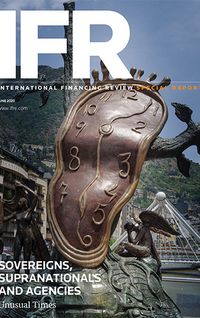The Covid-19 pandemic prompted the UK’s debt management office to overhaul its funding strategy, putting it on course to hit its £225bn target by the end of July.
Just weeks after the UK DMO set its 2020 funding target, Covid-19 hit and it was forced to redraw its borrowing plans, upping the pace and scale of its issuance programme as the treasury unveiled a series of measures to support companies and individuals through lockdown.
In April, the DMO raised its Gilts sales target to £45bn, before announcing plans to raise an additional £180bn between May 1 and the end of July 2020, bringing its total target for the first seven months of the year to £225bn, compared to £220bn raised across the full 2019/20 financial year.
As of the end of May, the DMO had raised £121bn - or roughly half of its target - after overhauling its strategy and scoring a series of firsts, combining more frequent auctions with record-breaking quick-fire syndications helped by a supportive Bank of England.
The DMO has hit upon a winning formula, although the uncertainty of Covid means the outlook remains uncertain, and the issuer is not taking anything for granted.
“We are not complacent, because the scale and pace of financing we’re facing is unprecedented. We take huge comfort from how well all participants of the market are functioning in an unusual environment,” said Sir Robert Stheeman, DMO chief executive.
The DMO’s first step to reach the new target was to change its schedule of operations, from around one auction every week to two auctions per day on consecutive days. By the end of April, it had exceeded the £45bn target, boosted by higher proceeds from the Post Auction Option Facility, after the DMO increased the rate of the facility to 25% from 15% - giving successful auction bidders an opportunity to purchase more Gilts than ever before. The facility was raised to 15% in 2016, after being set at 10% after the last financial crisis.
The DMO has developed a close relationship with its primary dealers and the smooth auction sales were helped by clear market signalling.
“The supply has been easily absorbed because there has been a very detailed auction schedule and the DMO has been transparent,” said one senior banker.
As well as more frequent auctions, the DMO ran two big syndications in May – a £12bn inaugural 10-year that was the first time it had issued paper shorter than 25 years in such a manner, followed by a £7bn 41-year. Ever since its first syndicated deal in 2009, the DMO has favoured the very long end of the curve to suit the demand from its hardcore domestic investor base of UK pension funds, the captive buyers of UK Gilts which dominate the order books.
The decision to print an inaugural 10-year via syndication as opposed to auction was driven by the need to raise an unprecedented amount of debt in a short time frame.
“We launched a new conventional 10 year via syndication so we could achieve a larger size than we would via one auction alone," said Stheeman. In order to establish a liquid 10-year benchmark, you need to issue around £10bn in size.” He said it would normally have taken three or four attempts to build to this size if it had done so by auction. “Rather than wait, we did this in one go. Size and speed were important factors.”
The decision paid off and enabled it to diversify its investor base, with 25% of orders coming from international buyers and the overall order book reaching a record £82bn – the biggest ever for a DMO syndication, encompassing an unprecedented 171 orders.
“The 10-year maturity is the most liquid part of the curve, enabling the widest possible investor base to participate. In particular, we saw strong demand from overseas central banks, and sovereign wealth funds,” said Stheeman.
With such a big order book, the DMO could have tightened pricing further but its approach is to create a constructive backdrop for future deals.
“When it comes to auctions we regard ourselves as price-takers, said Stheeman, "we are not in some way trying to dictate price. We assume that the market is liquid and sophisticated enough to establish a clearing price for any auction. We cannot therefore have a role in terms of cost minimisation at auction pricing, nor do we want to approach the market in an opportunistic way.
"It’s slightly different for a syndication where bookbuilding is more of an iterative process. In that case, there can be a trade-off between minimising the cost to the taxpayer and accepting a price that is attractive enough to encourage future investor participation.”
The 2061 issue was snapped up by the DMO’s traditional investor base, with demand soaring to £52bn and 93% of the allocation going to domestic buyers. Across the two deals, the DMO raised £19bn in its first back-to-back large syndications in consecutive weeks.
Despite the size of the syndicated trades, the DMO has not relied on this debt-raising strategy any more than usual. So far this year, syndication volumes have accounted for 15.7% of total DMO supply, compared with 20% in 2019.
Philip Brown, managing director in sovereign capital markets at Citigroup said: “We see this spate of Gilt syndications as a one-off in the sense that that the market understands that the government needs cash now and there is therefore a front-loading of the increase in the remit. It’s the same with the auction schedule. The Gilt market has been well prepared by the DMO and finds it straightforward to deal with this increase in supply when it knows that it’s coming. The transparency of the process has been very helpful.”
The DMO plans another in the first half of June, when it is expected to establish a new 30-year benchmark.
HELPFUL OLD LADY
While the DMO has won plaudits for its clear messaging around the supply, another big factor in its success has been the Bank of England’s asset purchase facility. On March 19, the central bank’s monetary policy committee expanded the APF by £200bn, with the majority of the additional asset purchases dedicated to corporate bonds. Also, the bank upped its bond schedule to buy three separate maturity buckets on each purchase day.
Mike Riddell, head of UK fixed income at Allianz Global Investors aid: “There’s a lot of focus on how much the DMO is going to issue and where on the curve all the supply will come. But, as is usually the case, particularly in times of crisis, the gross supply from the DMO is largely irrelevant.
“What matters for Gilt investors is how much the BoE will end up buying against this. If the BoE buys more Gilts than the DMO is issuing, as has been the case since the virus broke, then you have negative net supply and you’ll probably find Gilts rally. Which is exactly what has happened so far.”
But bankers are quick to point out that the success is not simply down to central bank largesse.
“The Bank of England has been a massive plus, and without this QE, yields would have been a lot higher. But the bank is not the only bid in town and QE isn’t forcing yields to a level that deters third-party buyers. On the contrary, we continue to see a continuous and significant bid from real money accounts buying the market at these yields,” said Citigroup’s Brown.
The DMO is expected further funding plans at the end of June but timing and size of future issuance will depend on a number of factors – the pace at which the UK economy reopens, and whether a second wave of infections forces the government to extend liquidity schemes.
The Bank of England’s ongoing support will be key, with bankers expecting it to continue its programme when its current firepower runs out over the summer. Armin Peter, global head of syndicate at UBS said: “Central banks have played a material role, and that can be seen in credit market valuations versus the macro environment and political landscape. You can’t play against the central bank.”
The DMO may also have to contend with the spectre of negative rates should the MPC decide to cut further. In an auction on May 20, the DMO sold the best part of a nominal £4bn of three-year Gilts by auction at a yield of negative 0.003% - the first time it has borrowed at a negative interest rate.
There are two ways of looking at negative rates. On the one hand, they present an opportunity for the DMO to raise cheaper debt but on the other deter some investors. But, overall, bankers point to the fact that UK Gilts enjoy both a safe-haven status and a captive buyer base, factors that along with BoE support will enable the DMO to meet its funding requirements.
The experience of other countries with negative rates should also provide grounds for optimism, suggesting that the pricing was more of a symbolic moment than a significant one. "As we have seen in markets such as Switzerland, where negative rates have been present for a while, capital markets continue to function,” said Peter.
Brown added: “There are some investors who cannot take negative yields, but experience in Europe has shown they are no impediment to supply. I don’t see any clouds on the horizon for Gilt issuance, the market continues to look very attractive compared to core European government bond yields.”
The biggest risk remains the virus itself. “If the crisis lingers and we see a second wave, then the debt pile will increase and we could see a ‘crowding-out’ effect. But, as the crisis wanes, geopolitical concerns will come to the forefront and cap any yield move higher,” said one banker active in the sector.
Central banks will face a longer-term challenge of unwinding QE, something that sparked violent sell-off in the US taper tantrums as the Fed looked to unwind crisis-era stimulus in 2013.
“There will be a time when market dynamics change and reach a tipping point, either when central banks reduce their support or more debt is needed and purchase programmes cannot keep pace. Either scenario could lead to increased volatility,” said Peter.
To see the digital version of this report, please click here
To purchase printed copies or a PDF of this report, please email gloria.balbastro@refinitiv.com
![]()




























